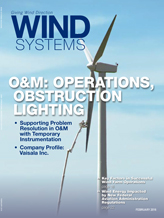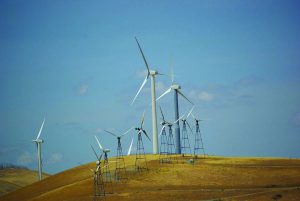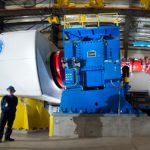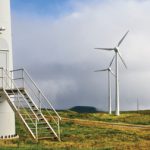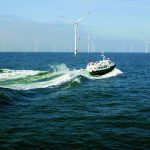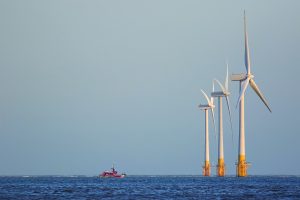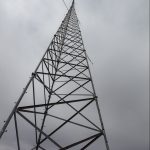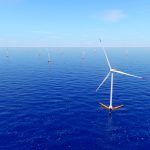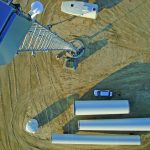As wind energy evolved in the United States and turbines appeared in trafficked airspace, the Federal Aviation Administration (FAA) worked to adapt existing regulations governing aviation obstruction lighting and marking to a new dynamic in vertical structures — rotating blades. A new FAA Advisory Circular (70/7460-1L) published in December 2015 illustrates an intensified effort to increase visibility of wind turbines for pilots of low-flying aircraft. This amplified focus also includes guidance for additional marking for turbine owners seeking to limit liability exposure beyond that afforded by full compliance to federal regulations.
MET Towers
The genesis of a typical wind farm begins with the investigation stage, usually with the placement of tower-supporting meteorological instruments to determine if the area is suitable for the development of a wind farm. These meteorological (MET) towers are often easily and swiftly erected with foundations that are much simpler than those required for a full-scale communication or broadcast tower with some that are even mounted on temporary mobile supports.
This inherent ability for rapid deployment, coupled with the lack of marking, created an unforeseen danger to low-flying aircraft. In the course of one or two days, a MET tower ranging from 60 to 199 feet above ground level (AGL) can be erected, posing a particular hazard to low-flying aircraft such as crop dusters who could encounter a tower directly in their path where none had previously existed.
Although standard FAA marking requirements normally do not address towers under 200 feet AGL in the absence of an airfield, airport, or other anomaly within 5 nautical miles of the determined site, to ensure pilot safety and prevent future incidents, several organizations, including the National Agricultural Aviation Association (NAAA), urged legislation on a state level to require marking (and often lighting) of MET towers.
In 2011, the National Transportation and Safety Board issued a safety alert for pilots who may fly at these heights, and the FAA also released guidelines for suggested marking. The FAA AC 70/7460-1L includes a distinct set of guidelines for marking MET towers in Section 2.7. These regulations include aviation orange and white paint bands on the tower structure and high-visibility sleeves and/or spherical markers on guy support wires.
The described MET tower marking is regarded as “voluntary” versus “required” by the FAA. However, many states have enacted statutes requiring the marking of MET towers. Currently in place as of January 2016: California, Colorado, Idaho, Kansas, Missouri, Montana, Nebraska, North Dakota, Oklahoma, South Dakota, Texas, Washington, and Wyoming. Sixteen other states currently have similarly proposed legislation on the docket. While they are rare, retroactive requirements for pre-existing structures are not unheard of, which could affect many older towers. Owners are strongly urged to research marking requirements on a state-by-state basis. In the absence of federal or state requirements, voluntarily marking pre-existing MET towers in accordance with these recently published FAA guidelines may reduce the tower owner’s exposure to liability and avoid local pressure to install lighting on the structure.
Revised Guidelines for Wind Turbines and Wind Farms
With the advancement of wind farms and turbine technology, the FAA began to address the need for proper marking of these structures as early as 1985 when it released AC 70/7460-1G and in 2007 when it devoted a separate chapter to wind turbine marking in AC 70/7460-1K Figure 1 Chg 2.

The newly released AC 70/7460-1L takes the marking and lighting of wind energy structures to a new level including more descriptive verbiage in Chapter 13 and four pages of illustrations in Appendix A. Aircraft Detection Lighting Systems (ADLS, or “radar” systems), which are sometimes associated with wind farms, have also been separated in Chapter 14. The FAA consulted several knowledgeable sources in the field of wind energy in an effort to address current and future needs, including taller structures and more elaborate farm designs.
Key Revisions
- Inspection and Monitoring: A visual inspection of obstruction light lenses is required at maximum intervals of 24 months. Though it is not a new requirement, daily monitoring logs for the lighting should be maintained as well. Replacement criteria for beacons or lenses are also included.
- Measurement: One key clarification in the AC 70/7460-1L is the measurement of the overall height of a wind turbine as depicted in Figure A-23 of Appendix A: “Turbine height is determined from the top of the rotor while at top dead center.” The illustration clearly indicates the measurement is from ground to the tip of the blade in its most skyward presentation. This differs from many previous interpretations that indicated this measurement should be to the top of the hub or nacelle.
- Lighting: Though not every structure in the wind farm is required to have obstruction lighting, section 13.8 addresses the “Lighting of Wind Turbines During the Construction Phase” and states “to ensure proper conspicuity of turbines at night during construction, all turbines should be lighted with temporary lighting once they reach a height of 200 feet (61 m) or greater until the permanent lighting configuration is turned on.” This section further describes detailed temporary lighting requirements as well.
- Farm Configurations: Wind farm configurations are separated into linear, cluster, and grid with associated marking requirements. Acceptable colors for wind turbines are now described in the European-based RAL color standard to accommodate the off-white colors of equipment commonly imported to the U.S. Voluntary marking for snow-prone areas has been established in an effort by the FAA to maintain uniformity and reduce potential confusion to pilots.
- L-810 Marker Synchronization: When combined with L-864 medium-intensity lighting on structures over 699 feet AGL under the new guidelines, L-810 obstruction lighting (“side marker lights”) must flash in synchronized fashion with the other lighting on the structure. This also means the L-810 will be considered a “flashing obstruction light” as covered in Section 2.4.2 of the advisory circular, meaning any failure will require NOTAM (Notice To Airmen), which, according to the FAA, is a notice or advisory distributed by means of telecommunication containing information concerning the establishment, conditions, or change in any aeronautical facility, service, procedure, or hazard. The timely knowledge of which is essential to personnel and systems concerned with flight operations.
- Aircraft Detection Lighting Systems (ADLS): While ADLS may not be financially feasible in the case of a smaller wind farm, they may be a necessary investment at larger farms. These systems are designed to detect any approaching aircraft within a proximity that could possibly result in an impact with the turbine.
The lighting system is normally not activated with the exception of a short test period each day. Once the approaching aircraft is detected, the system will normally send an audible alarm over all aviation-approved radio channels advising the pilot of the obstruction, and then immediately activate the lighting system. While this type of system may initially seem to be highly attractive due to the public appeal and energy savings from being chiefly inactive, it is relatively expensive to install and set up. Flybys must be performed using fixed-wing and rotor-blade aircraft to the activation function. Sensitivity to movement by other objects must be adjusted. The system was fine-tuned to filter and eliminate these distractions. Additional fly-bys were performed in a final test prior to declaring the accurate and safe performance of the system. Figure 2

Although costs to install, fine-tune, and test the ADLS are significant, the long-term benefits may prove in some areas to be worth the investment. Such systems are designed to address concerns for community and environmental safety, particularly in the interest of protecting population centers, natural attractions, coastlines, lakes, or large bodies of water and migratory birds and other wildlife that are drawn to red obstruction lighting. Figure 3

Accessing the Information
In conclusion, becoming familiar with the new FAA AC 70/7460-1L is a priority for everyone in the wind energy industry. Designed to address current safety challenges and to keep pace with anticipated future advancements, the circular is available free of charge to view or download through the FAA website. Go to www.faa.gov. Once at the home page, click on the Regulations & Policies tab. In the search bar, type in the current advisory circular pertaining to this article — “70/7460-IL.” Click on “Obstruction Marking and Lighting.” From there, download the AC 70/7460-IL PDF.
















